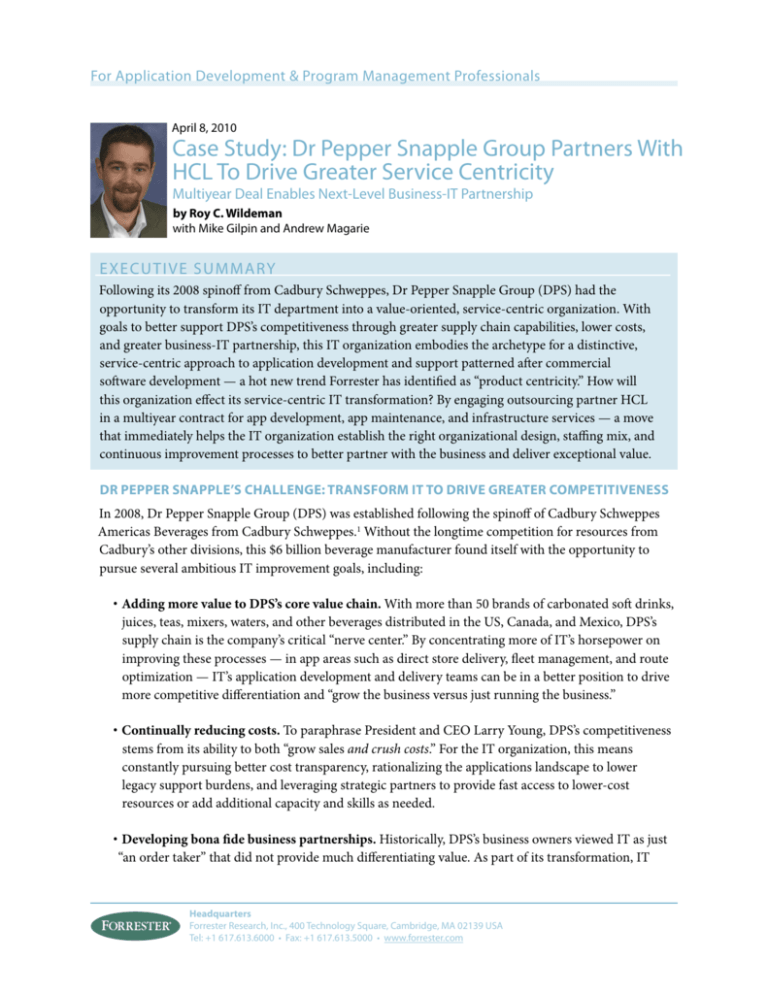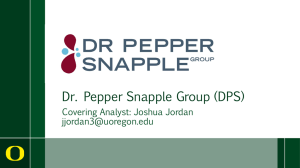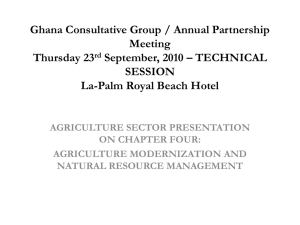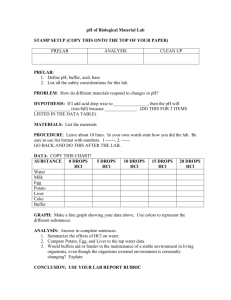
For Application Development & Program Management Professionals
April 8, 2010
Case Study: Dr Pepper Snapple Group Partners With
HCL To Drive Greater Service Centricity
Multiyear Deal Enables Next-Level Business-IT Partnership
by Roy C. Wildeman
with Mike Gilpin and Andrew Magarie
Executiv e S ummary
Following its 2008 spinoff from Cadbury Schweppes, Dr Pepper Snapple Group (DPS) had the
opportunity to transform its IT department into a value-oriented, service-centric organization. With
goals to better support DPS’s competitiveness through greater supply chain capabilities, lower costs,
and greater business-IT partnership, this IT organization embodies the archetype for a distinctive,
service-centric approach to application development and support patterned after commercial
software development — a hot new trend Forrester has identified as “product centricity.” How will
this organization effect its service-centric IT transformation? By engaging outsourcing partner HCL
in a multiyear contract for app development, app maintenance, and infrastructure services — a move
that immediately helps the IT organization establish the right organizational design, staffing mix, and
continuous improvement processes to better partner with the business and deliver exceptional value.
DR PEPPER SNAPPLE’s challenge: transform it to drive greater competitiveness
In 2008, Dr Pepper Snapple Group (DPS) was established following the spinoff of Cadbury Schweppes
Americas Beverages from Cadbury Schweppes.1 Without the longtime competition for resources from
Cadbury’s other divisions, this $6 billion beverage manufacturer found itself with the opportunity to
pursue several ambitious IT improvement goals, including:
·Adding more value to DPS’s core value chain. With more than 50 brands of carbonated soft drinks,
juices, teas, mixers, waters, and other beverages distributed in the US, Canada, and Mexico, DPS’s
supply chain is the company’s critical “nerve center.” By concentrating more of IT’s horsepower on
improving these processes — in app areas such as direct store delivery, fleet management, and route
optimization — IT’s application development and delivery teams can be in a better position to drive
more competitive differentiation and “grow the business versus just running the business.”
·Continually reducing costs. To paraphrase President and CEO Larry Young, DPS’s competitiveness
stems from its ability to both “grow sales and crush costs.” For the IT organization, this means
constantly pursuing better cost transparency, rationalizing the applications landscape to lower
legacy support burdens, and leveraging strategic partners to provide fast access to lower-cost
resources or add additional capacity and skills as needed.
·Developing bona fide business partnerships. Historically, DPS’s business owners viewed IT as just
“an order taker” that did not provide much differentiating value. As part of its transformation, IT
Headquarters
Forrester Research, Inc., 400 Technology Square, Cambridge, MA 02139 USA
Tel: +1 617.613.6000 • Fax: +1 617.613.5000 • www.forrester.com
Case Study: Dr Pepper Snapple Group Partners With HCL To Drive Greater Service Centricity
2
For Application Development & Program Management Professionals
sought to improve its ties to the business, import best practices and innovations to help bring
new capabilities to the business faster and with lower risk, and enhance the perceived quality of
its application delivery and other services.
DPS PARTNERS WITH HCL TO PROMOTE greater service CENTRICITY
With pressures to deliver more top-line business value, reduce costs, and improve partnership
with the business, DPS fits the archetype for a distinctive, service-centric approach to application
development and support patterned after commercial software development — a hot new trend
Forrester has identified as “product centricity.”2 Notably, Forrester envisions the product- or servicecentricity trend occurring regardless of whether internal or outsourced resources do the bulk of the
work and whether the work occurs at a centralized site or is more globally distributed.3 For proof,
application development professionals need look no further than DPS’s recent deal with HCL: a
multiyear contract signed in June 2009 for app development, app maintenance, and infrastructure
services that is helping the company assemble the right service-centric parameters to forge nextlevel partnership with the business and deliver exceptional value. These parameters include:
·A business-aligned service delivery organization. To ensure that service delivery is continually
in step with the company’s business environment, dedicated service delivery managers (SDMs)
are staffed on site, aligned to each of DPS’s three business groups (supply chain, packaged
beverages, and corporate and commercial). At the executive level, HCL domain experts act
as delivery heads and interact continually with the DPS business partner organization on
industry best practices and approaches, while at the operational level, HCL SDMs provide endto-end incident management. The result? DPS can call on HCL to help tackle both strategic
management issues, such as reducing shrinkage and achieving on-time delivery, and day-today
problems, such as app latency and downtime, with a “one-stop-shop” liaison who can own the
problem and seek resolution across technology silos.4
·A value-driven service improvement approach. Just as commercial software companies must
prioritize their product road maps and requirements backlog to maximize customer value, so
too must IT organizations sift through the mountains of backlog requests to correctly prioritize
service delivery work. To help DPS IT navigate this challenge, HCL is first mapping business
processes via its Enterprise Discovery Framework alongside formalized key performance
indicators (KPIs) and process cycle-time reduction goals for each area. Thereafter, a
ProcessWatch dashboard will focus on problematic subprocess areas, comparing actual incident
resolution performance to target KPIs and alerting process owners when a recurring problem
has business impact. Development started with the critical Customer-to-Cash subprocess area.
To gauge the importance of strategic, longer-term development work, HCL is using a PRIZM
design tool that maps problem incidents to more than 120 different application attributes, such
as functionality and performance quality, to help make objective, data-driven recommendations
on application replacement or rationalization.
April 8, 2010
© 2010, Forrester Research, Inc. Reproduction Prohibited
Case Study: Dr Pepper Snapple Group Partners With HCL To Drive Greater Service Centricity
3
For Application Development & Program Management Professionals
·A more centralized IT support team, motivated to generate additional value. In addition
to the usual cost savings that come from consolidating outsourcing support across historically
decentralized IT domains, DPS is expecting additional cost and cycle-time reductions over its
multiyear engagement with HCL. To help deliver on these expectations, HCL is implementing
its Co-creating Value portal — a proven method for capturing and aggregating improvement
suggestions at client sites that fosters automation innovations and “democratizes value creation”
across its talent pool.
next steps: successful execution oF the service-centric strategy
DPS is still in the first year of its transformational journey, but the company has put a series of
controls and management structures in place that will help make its service-centric improvement
goals stick and enhance the success of its partnership with HCL, including:
·A commitment to reduce IT complexity. Using HCL’s PRIZM design tool as a compass, DPS
aims to consolidate its infrastructure, modernize and rationalize large-scale applications such as
enterprise resource planning (ERP) applications, and assimilate problematic interfaces into its
enterprise SAP strategy, steadily eliminating undue complexity and enabling faster app delivery
and lower support costs.
·An engagement contract that locks in cost reduction. Prior to embarking on its
transformation, DPS saw its IT operational costs climbing — though it remains a relatively
low-cost operation in terms of company revenues spent on IT. Despite this past disadvantage,
DPS is confident that it can achieve cost reductions through its partnership with HCL — a
commitment formalized as part of its five-year contract that includes firm agreements
for executing on both upfront cost reductions as well as ongoing savings from continuous
improvement programs.
Endnotes
1
DPS was established in 2008 following the spinoff of Cadbury Schweppes Americas Beverages from
Cadbury Schweppes, which had formed in 2003 by bringing together Cadbury Schweppes’ four North
American beverages businesses: Dr Pepper/Seven Up Inc., Snapple Beverage Group, Mott’s LLP, and
Bebidas Mexico. DPS now manufactures, bottles, and distributes more than 50 brands of carbonated soft
drinks, juices, teas, mixers, waters, and other beverages.
2
Forrester defines this new archetype of product- or service-centric IT organizations as using a characteristic
set of organizational structures, processes, and people to better harness customer input, cut through
technology complexity, and repeatedly deliver high-value software applications that drive competitive
advantage for the business. See the December 23, 2009, “Product-Centric Development Is A Hot New
Trend” report.
April 8, 2010
© 2010, Forrester Research, Inc. Reproduction Prohibited
Case Study: Dr Pepper Snapple Group Partners With HCL To Drive Greater Service Centricity
4
For Application Development & Program Management Professionals
3
Product centricity and service centricity are really two different terms for the same distinctive approach to
software development; one or the other term is used depending on whether a company is in the business of
“products” or “services.”
4
In keeping with HCL’s service-centric approach, these SDMs have responsibility for diagnosing and
resolving incidents even if the root problem is outside the purview of HCL’s managed services, as is the case
with the DPS’s data centers and servers.
Forrester Research, Inc. (Nasdaq: FORR) is an independent research company that provides pragmatic and forward-thinking advice to global leaders in business
and technology. Forrester works with professionals in 20 key roles at major companies providing proprietary research, customer insight, consulting, events, and
peer-to-peer executive programs. For more than 26 years, Forrester has been making IT, marketing, and technology industry leaders successful every day. For
more information, visit www.forrester.com.
© 2010, Forrester Research, Inc. All rights reserved. Unauthorized reproduction is strictly prohibited. Information is based on best available resources. Opinions
reflect judgment at the time and are subject to change. Forrester®, Technographics®, Forrester Wave, RoleView, TechRadar, and Total Economic Impact are
trademarks of Forrester Research, Inc. All other trademarks are the property of their respective companies. To purchase reprints of this document, please email
clientsupport@forrester.com. For additional information, go to www.forrester.com.
56160







